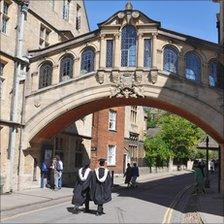What will a tuition fees market mean?
- Published

Universities will have to balance an equation of costs, quality and demand
The political desire to create a market in tuition fees has driven reform ever since Tony Blair reversed the Labour Party's 2001 manifesto promise not to introduce so-called "top-up fees".
His government introduced a "variable" fee system, with an index-linked cap starting at £3,000. It was meant to create a market, with some charging up to the limit and others well below. It failed.
A couple of institutions set fees below the cap, most notably Leeds Metropolitan which charged £2,000. It proved unsustainable and Leeds Met put the cost at £10m.
Despite this salutary precedent, Lord Browne's proposals should - just about - be enough to create a fees market, albeit a hybrid one.
It will be a delicate balancing act for universities who know that debt-conscious students may shop around for competitive prices while at the same time recognising the risk that lower fees might be equated with lower prestige.
Those who favour a market usually cite the advantages of the US university system.
In his autobiography, Mr Blair argued that the US's domination of international university league tables was "plainly and inescapably" due to their free market fees system. As he put it bluntly: "Those who paid top dollar got the best."
So will Lord Browne's review have done enough to create a genuine fees market and, if so, what are the likely effects on universities and students?
Most experts agree that if Browne had lifted the cap to only £5,000, virtually all universities would have raised fees to that limit.
On the other hand, if he had gone for a £7,000 cap, there would have been real variation.
The chair of the Million+ group of universities, Les Ebdon, has predicted that "only the most socially elite universities could charge fees of £7,000".
So a £6,000 cap takes us into "no-man's land".
However, the additional flexibility for universities to break the so-called "soft cap" - albeit at the cost of handing over some of the proceeds to the Treasury - probably tips the balance closer to a US-style market.
'Champagne subsidy'
While it seems likely that most universities will hover around the £6,000 limit, some in the Russell Group may well be tempted higher.
Cambridge University, for example, puts the real cost of teaching undergraduates under its labour-intensive tutorial system at around £9,000.
Differential fee levels would deal with what Professor Nick Barr, of the LSE, has called "the champagne drinkers' subsidy", whereby students currently pay the same whether they get their degree from Oxford or "Balls Pond Road Tech".
In the US, where a market has operated for years, the system has become highly differentiated, ranging from the elite private universities, to four-year public universities, down to two-year community colleges.
At the top end, tuition can cost $50,000 (£32,000) a year. At the bottom end it is more like one-twentieth that amount.
The flexibility of the US system of credit-based degrees means students can do two years at community college and then complete their studies at a more expensive and prestigious university.
That sort of flexibility may well become increasingly the norm in England if the market takes hold.
Negative side
But although the US market system has benefits, it also brings problems.
On the plus side are the highest concentration of world-leading universities, one of the highest graduation rates in the world and one of the highest participation rates among poor students.
But, as Roger Brown from Liverpool Hope University has argued in his report Where the US Goes Today…, there is a negative side.
In the US, tuition fees have risen four times faster than other prices over the past 20 years. At the same time government funding has fallen - something that universities here really fear with the Comprehensive Spending Review just ahead.
The result is that the gap between the richer and the poorer universities has widened and low-income students have been increasingly clustered around the cheaper universities.
One really sobering lesson from the US is that the huge rise in fees has not led to a proportionate rise in education quality.
American economist Richard Vedder has estimated that only 21% of fee income actually goes into universities' teaching costs, with the rest going on subsidising research, improving facilities, and funding burgeoning administration.
The desire to outdo rivals has led to an "academic arms race" with universities charging ever-higher fees to fund more lavish facilities and world-beating research.
And this is the crux of Roger Brown's argument: because there can be no "bottom line" in higher education, as there is in commercial businesses in terms of a direct measure of product quality, the focus instead is on proxies such as status and prestige.
However, Universities Minister David Willetts believes that in return for higher fees, universities must improve the student experience so the government will push for better consumer information on things like teaching hours and employment prospects.
There is another phenomenon from the US which many see as a warning: a recent backlash against high tuition fees, together with the growth of new profit-making providers who are spotting a niche in the market.
The University of Phoenix, a for-profit institution owned by the Apollo Group, has seen huge demand for its relatively cheap degrees delivered largely via the internet.
David Willetts wants to see new providers like this entering the market and recently granted university college status to BPP College in London, which has been acquired by the very same Apollo Group.
So a market in fees? It looks likely. Some benefits? Yes, especially for leading universities and students who can afford them.
But there are also worrying precedents on rising costs, value for money and the dangers of social segregation.
Mike Baker is a freelance journalist specialising in education.http://www.mikebakereducation.co.uk/, external